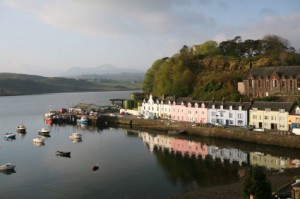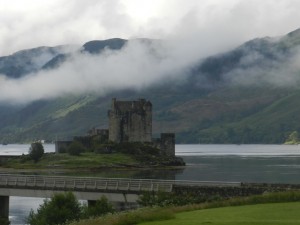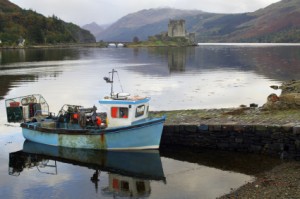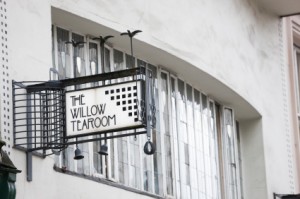 As a child, I was first introduced to the Isle of Skye through my Scottish history lessons and the ‘Skye Boat Song’. Both told tales of how Bonny Prince Charlie, with the help of Flora MacDonald, escaped to Skye after his defeat at the Battle of Culloden in 1746. Perhaps it’s as a result of these tales but Skye has always intrigued me and conjured up romantic, mystical images of passion, historic feuds and bloody battles.
As a child, I was first introduced to the Isle of Skye through my Scottish history lessons and the ‘Skye Boat Song’. Both told tales of how Bonny Prince Charlie, with the help of Flora MacDonald, escaped to Skye after his defeat at the Battle of Culloden in 1746. Perhaps it’s as a result of these tales but Skye has always intrigued me and conjured up romantic, mystical images of passion, historic feuds and bloody battles.
This is a unique environment and the scenery inspires and stirs the senses (as Virginia Woolf testifies in ‘To the Lighthouse’). Skye is a place of extremes and presents many faces. The coastline is a series of peninsulas and bays radiating from a centre dominated by the stark, black rise of the jagged Cuillin hills. In contrast, a busy patchwork of little sandy beaches, inlets, bays and islands, tiny villages and historic keeps scatter the landscape. Breathing beneath every footstep lies 500 million years of history, and yet above ground, every passing cloud or ray of sunshine can totally change the personality and feel of the place in an instant.
This is the place National Geographic voted the fourth best island in the world.
Enjoy the journey
So often we hear phrases like ‘life isn’t the destination, it’s the journey’, or ‘it’s not just about the destination, but the journey too’. Getting to the Isle of Skye is a bit like that. The surrounding scenery is so beautiful and interesting, you can have as much fun getting there – and it’s very easy to get there these days.
Caledondian MacBrayne operate ferry services to and from the island on routes from Armadale to Mallaig and from Uig to The Western Isles. In addition there are CalMac ferries serving Raasay from Sconser and The Small Isles (Canna, Rùm, Eigg and Muck) from Mallaig.
Alternatively, why not hop on the train. ScotRail run services throughout the UK to Kyle of Lochalsh and Mallaig. The scenery along these rail routes is stunning and cannot be recommended highly enough.
We decided to travel via the Skye Bridge, which spans from Kyle of Lochalsh to Kyleakin. For most people this will be your gateway to Skye. Though originally a toll bridge, there is now no toll so access to the Island across the bridge is free.
Portree
Once on the island, it can be difficult to decide what to see and do. At 1,656 square kilometres Skye is the second-largest island in Scotland after Lewis and Harris – so there’s plenty of ground to cover. Of all the Inner Hebrides, Skye has the most in common with the Outer Hebrides, with half the population speaking Gaelic, and many belonging to the Free Church of Scotland, known for its strict observance of the Sabbath. I remembered my best friend, whose mother came from Lewis, telling me you couldn’t listen to the radio or mow your lawn on a Sunday. It is ‘strictly’ a day of rest.
We decided to head to the island’s main town of Portree. It is a popular spot and is well known for its picturesque natural harbour.
Portree is also the cultural hub for Skye and one of its main attractions, the award-winning Aros Centre, runs regular theatre, concerts and film screenings. The centre also incorporates an exhibition capturing the drama of Skye’s history, a spectacular RSPB exhibit with live and recorded footage of rare sea eagles plus an audio-visual presentation giving a dramatic aerial view of Skye’s incredible landscapes.
If you like the harbour/seaside feel then you will enjoy the hustle and bustle of Portree. For those handy with a camera, the painted buildings, jostling for position along the water’s edge make a great snapshot in their own right. Of course, as with any seaside location, you need to share your walk, and possibly your fish and chips, with some of the largest seagulls I have ever seen in my life.
Pre-historic meets modern day
If you prefer a bit of history, then there are plenty of historical sites to interest you on Skye – pick any period over the last 500 million years.
Columba is said to have visited Skye shortly before 697, but it was the Norse that held power throughout the Hebrides from the 9th century until after the Treaty of Perth in 1266. Little remains of their presence in the written or archaeological record on Skye.
One of the two most powerful clans on the Island, Clan MacLeod, claims Viking heritage and Norse tradition is celebrated in the winter fire festival at Dunvegan, during which a replica Viking long boat is set alight.
Skye has a rich heritage of ancient monuments and castles. Dunvegan Castle has been the seat of Clan MacLeod since the 13th century. It contains the Fairy Flag (I’ll leave you to do your research on that one) and is reputed to have been inhabited by a single family for longer than any other house in Scotland. One of the highlights for me, was seeing a waistcoat that belonged to Bonnie Prince Charlie mounted on the wall. Quite amazing to think he actually wore that.
Elsewhere on Skye is the 18th century Armadale Castle, once home of Clan Donald of Sleat, but was abandoned as a residence in 1925. It now hosts the Clan Donald Centre, so if you are interested in Clan history, you should drop in.
Nearby are the ruins of two more MacDonald strongholds, Knock Castle, and Dunscaith Castle, built in the late 15th century near Kyleakin and once a seat of Clan MacKinnon, is another ruin.
Sadly, the Highland Clearances had a major impact on the population of Skye and the ruins of a cleared village can be seen at Boreraig, Strath Swordale.
A taste of Talisker
Of course, no trip to Skye would be complete without making mention of the Talisker Distillery which lies on Loch Harport on the west coast of the Isle of Skye. If you are a fan of this peaty drop then make time to head over and sample some local produce.
I could never do the Isle of Skye justice in this short post, but rest assured, Skye has it all. Hopefully I have provided you with the essence of this remote spot, and perhaps inspired you to make the trip – over the sea to Skye.
 I hadn’t thought too much about what we were going to do once we actually arrived in the Kyle of Lochalsh. All that was driving me to this point was a desire to see Kintail and its surrounding area, try to find out a little bit about the MacRaes, and to visit Eilean Donan Castle. However, I soon realise that the three days we have planned here are not enough to fully explore all that the Kyle of Lochalsh has to offer.
I hadn’t thought too much about what we were going to do once we actually arrived in the Kyle of Lochalsh. All that was driving me to this point was a desire to see Kintail and its surrounding area, try to find out a little bit about the MacRaes, and to visit Eilean Donan Castle. However, I soon realise that the three days we have planned here are not enough to fully explore all that the Kyle of Lochalsh has to offer. Send to Kindle
Send to Kindle




Recent Comments